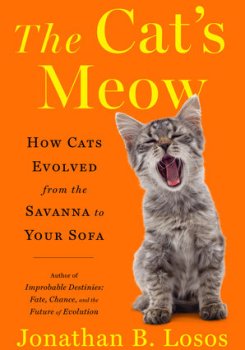The Paradox Of The Modern Cat
If your house cat were the size of a lion, would it try to eat you? Author Jonathan B. Losos explores just how domesticated cats really are.
The following is an excerpt from The Cat’s Meow: How Cats Evolved from the Savanna to Your Sofa by Jonathan B. Losos.
Disclaimer: When you purchase products through the Bookshop.org link on this page, Science Friday may earn a small commission which helps support our journalism.

The Cat's Meow: How Cats Evolved from the Savanna to Your Sofa
It’s a good thing cats aren’t the size of large dogs, says an old joke, because if they were, they’d eat their owners. As a cat-loving scientist, my first reaction was to laugh, quickly followed by the thought, “How can I research this idea?” Sadly, even science has its limits. Until we’re able to produce seventy-five-pound housecats, we’ll never get a definitive answer.
That’s not to say that science is entirely silent on the question. A 2014 research paper was widely reported to conclude that “Cats Would Kill You if They Were Bigger” as the Orlando Sentinel put it in their headline. USA Today eliminated the subtleties, declaring “Your Cat May Want to Kill You.”
In reality, the paper said no such thing. Rather, the scientists compared behavioral tendencies, such as aggressiveness and sociability, among five feline species ranging in size from the housecat to the African lion. The paper’s primary conclusion was that personality-wise, there aren’t many differences among cats, regardless of size. Zookeepers have told me the same thing: if you can read the expressions and body posture of your cat, you can understand what a lion or tiger is thinking. The researchers did not suggest that housecats, were they the size of lions, would be sizing you up for supper—it was the journalists and bloggers who made that leap.
Regardless of its implications for potential man-eating moggies, the research reveals an important fact: in many ways, a cat’s a cat, whatever its size. This finding will come as no surprise to anyone who’s spent hours watching internet videos of tigers chasing laser pointer dots, leopards jumping into cardboard boxes, and lions rolling in catnip.
The point that our household friends are little different from their wild relatives was driven home to me a few years ago on a trip to South Africa with my wife, Melissa. While driving around at night near Kruger National Park, a common sighting was a slender, tawny feline, faintly spotted or striped, the small cat caught in the spotlight’s glare for just a moment before he darted back into the shadows.
The first couple I saw were reasonably close to the game lodge where we were staying. Based on their size and appearance, I presumed they were pets that belonged to one of the staff members, or perhaps the lodge kept them to keep rodents in check. In any case, they certainly seemed to be domestic cats, out for a ramble in the African wilderness. No good can come of this, I thought, with all the larger predators about, but that’s their business, not mine. So, I didn’t pay much attention to these small waifs, nor was I disappointed when they quickly disappeared back into the bush—I’d try to give them a nice pat when I saw them back in camp.
But one day we encountered one of these cats miles from the lodge and I realized that this could not be anyone’s pet. And, indeed, he wasn’t—he was an African wildcat, the species from which domestic cats arose (we’ll discuss in Chapter Six how we know this). Further scrutiny revealed distinctive features: legs longer than most domestic cats and a striking black-tipped tail. Still, if you saw one from your kitchen window, your first thought would be “Look at that beautiful cat in the backyard,” not “How’d that African wildcat get to New Jersey?”
In terms of behavior, too, most domestic cats differ little from their ancestors. Sure, they’re friendlier—or at least more tolerant—of humans, and sometimes more sociable to each other, but in other ways—their hunting, grooming, sleeping and general manner—they behave just like wildcats. Indeed, the ease with which abandoned cats go feral and revert to their ingrained, ancestral ways is evidence of how little the domestic cat has evolved.
For this reason, domestic cats are commonly referred to as “barely” or “semi-domesticated.” Domestication is the process by which animals and plants are modified by their interactions with humans in a way that benefits us . By “modified,” I mean they have evolved through genetic changes that result in behavioral, physiological and anatomical differences from their ancestors.
In contrast to cats, “fully domesticated” species are substantially different from their wild ancestors. Consider the barnyard pig. Big, portly, pink, curly tail, floppy ears, very little hair. Sus domestica is the quintessential domesticated animal, a species sculpted by humans, greatly modified from the ancestral boar (Sus scrofa) to suit our needs and desires. Or contemplate cows, far removed from their majestic wild cattle ancestors, turned into meat-and milk-producing machines by our selective breeding over the millennia. Similar selection applied to plants has created our food crops like corn and wheat, vastly different from their wild progenitors.
Not so for domestic cats. Look underneath the paint job—the variation in hair length, color and texture—and most domestic cats are nearly indistinguishable from wildcats. The differences in anatomy, physiology, and behavior that distinguish most domesticated species from their ancestors don’t exist in cats.
Recent genome studies confirm this view. Whereas dogs have diverged from wolves in many genes, domestic cats and wildcats differ in only a handful. Cats truly are scarcely domesticated.
Copyright © 2023 by Jonathan B. Losos